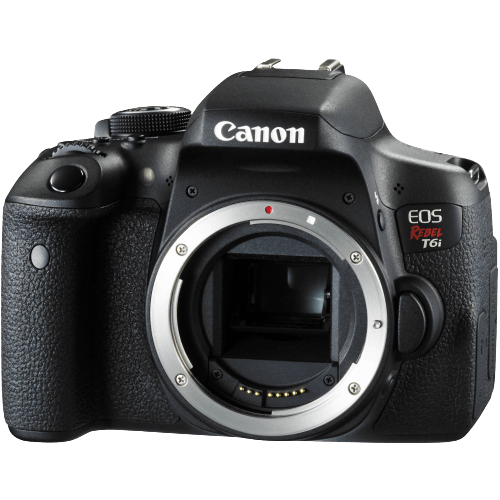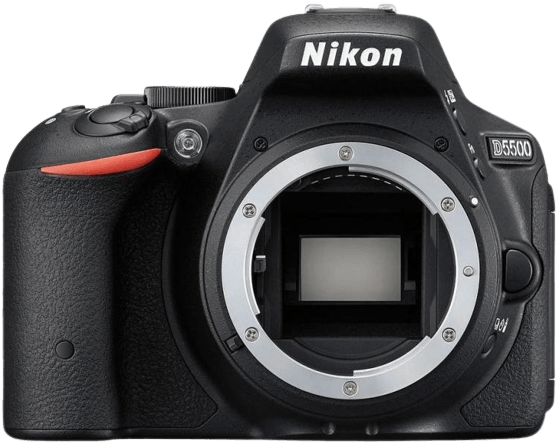Canon EOS Rebel T6i / 750D vs Nikon D5500 Comparison
Canon EOS Rebel T6i / 750D

Nikon D5500

The Nikon D5500 takes the lead in our comparison with a score of 61/100, while the Canon EOS Rebel T6i / 750D trails behind with a score of 56/100. Both cameras share common specifications as they are DSLR cameras released in 2015, with the Canon T6i being announced in February and the Nikon D5500 in January.
The Nikon D5500 outperforms the Canon T6i with its lighter weight at 420g (0.93lbs) and smaller dimensions of 124 x 97 x 70mm, making it more compact and portable. However, the Canon T6i boasts a more budget-friendly launch price of $750 compared to the Nikon D5500’s $900.
Taking these points into consideration, the Nikon D5500 emerges as a better option for those prioritizing portability, while the Canon T6i is a more cost-effective choice for budget-conscious buyers.
Canon EOS Rebel T6i / 750D vs Nikon D5500 Overview and Optics
The Nikon D5500 is the winner in the optics category, scoring 65/100, while the Canon EOS Rebel T6i / 750D scores 59/100. Both cameras share several specifications, including 24.2 megapixels, a shooting speed of 5, a CMOS sensor type, an APS-C sensor size, and no image stabilization. Additionally, both cameras have different lens mounts, with the Canon using an EF-S mount, and the Nikon using an F DX mount.
The Nikon D5500 outperforms the Canon T6i in terms of sensor performance, as it has a higher DXOMARK score of 84, compared to the Canon’s score of 71. This higher score means that the Nikon D5500’s sensor captures better image quality, especially in low-light conditions. Additionally, the Nikon D5500 uses an Expeed 4 processor, which contributes to its superior image processing capabilities.
On the other hand, the Canon T6i features a Digic 6 processor, which may not be as advanced as the Nikon’s Expeed 4 processor, but still delivers good image quality. The Canon T6i also has a versatile EF-S lens mount, which is compatible with a wide range of Canon lenses, offering flexibility for photographers.
Considering the optics performance, the Nikon D5500 stands out with its higher DXOMARK sensor score and advanced Expeed 4 processor. This camera delivers better image quality and low-light performance. However, the Canon T6i is not far behind, offering good image quality and a versatile lens mount. Ultimately, both cameras have their strengths, and the choice between them will depend on the individual photographer’s needs and preferences.
Canon EOS Rebel T6i / 750D vs Nikon D5500 Video Performance
The Nikon D5500 outperforms the Canon EOS Rebel T6i / 750D in video capabilities, with a 27-point advantage in video score (70/100 vs. 43/100). Both cameras share some common specifications, such as Full HD video resolution and maximum video dimensions of 1920 x 1080. However, there are notable differences that give the Nikon D5500 an edge.
The Nikon D5500 has a higher max video frame rate at 60fps, compared to the Canon T6i / 750D’s 30fps. This difference allows the Nikon D5500 to produce smoother and more detailed videos, especially in fast-paced scenes or when capturing sports events. Furthermore, the Nikon D5500 has built-in time-lapse functionality, which enables users to create stunning time-lapse videos without the need for additional software or equipment.
On the other hand, the Canon T6i / 750D does not offer any significant advantages in video capabilities over the Nikon D5500. Its lower video score and lack of time-lapse functionality make it less versatile for videographers.
Considering these points, the Nikon D5500 emerges as a better choice for those looking to capture high-quality videos with more advanced features. Its superior video frame rate and time-lapse functionality provide users with a more versatile and powerful tool for capturing memorable moments. In contrast, the Canon T6i / 750D falls short in these aspects, making it less suitable for users who prioritize video capabilities in their camera selection.
Canon EOS Rebel T6i / 750D vs Nikon D5500 Features and Benefits
The Nikon D5500 takes the lead in the feature comparison with a score of 59/100, slightly ahead of the Canon EOS Rebel T6i / 750D’s score of 57/100. Both cameras share several specifications, such as a touchscreen, flip screen, WiFi connectivity, and the absence of GPS and Bluetooth.
The Nikon D5500 stands out with its larger screen size of 3.2 inches, compared to the Canon T6i’s 3-inch screen. This extra screen space provides a more comfortable experience for users when navigating menus or reviewing images. Additionally, the D5500’s screen resolution is marginally higher at 1,037,000 dots, as opposed to the T6i’s 1,040,000 dots, resulting in slightly crisper image previews and clearer menu navigation.
The Canon EOS Rebel T6i / 750D, on the other hand, does not have any notable advantages over the Nikon D5500 in terms of features. Both cameras are evenly matched in most aspects, which means the T6i’s strengths lie in other areas such as general specifications, optics, and video performance.
When comparing the Canon EOS Rebel T6i / 750D and Nikon D5500, the D5500’s larger screen size and marginally higher screen resolution make it the winner in terms of features. However, the T6i remains a strong competitor, and potential buyers should consider other factors such as general specifications, optics, and video performance when making a final decision. Both cameras have their strengths, and the choice ultimately depends on the user’s preferences and requirements.
Canon EOS Rebel T6i / 750D vs Nikon D5500 Storage and Battery
The Nikon D5500 outperforms the Canon EOS Rebel T6i / 750D in the storage and battery category, scoring 35/100 compared to the Canon’s 24/100. Both cameras have one memory card slot and accept SD, SDHC, and SDXC cards. Neither camera offers USB charging.
The Nikon D5500 has a significantly longer battery life, providing 820 shots per charge, while the Canon T6i / 750D only delivers 440 shots. The D5500 uses the EN-EL14 battery type, whereas the T6i / 750D uses the LP-E17 battery.
The Canon T6i / 750D does not have any clear advantages in this category. However, its compatibility with UHS-I memory cards may offer slightly faster read/write speeds compared to the Nikon D5500.
Considering the longer battery life and similar storage capabilities, the Nikon D5500 proves to be the superior choice in this comparison.
Alternatives to the Canon EOS Rebel T6i / 750D and Nikon D5500
Are you still undecided about which camera is right for you? Have a look at these popular comparisons that feature the Canon EOS Rebel T6i / 750D or the Nikon D5500:

